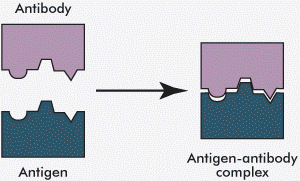Introduction
Humoral response
Cell-mediated response
Vaccinations
Introduction
The specific immune response is split into humoral immunity and cell-mediated immunity. Humoral is to do with the blood and antibodies. Distinguishing between an antigen and an antibody is very important.
Antigen = protein or carbohydrate foreign (not normally present) to a host’s organism
Antibody = protein made as a response to detecting an antigen which binds to the antigen and prevents the pathogen from harming the host.

Immunity against invading pathogens is a crucial part of maintaining health. The body has adaptations which prevent invasion by pathogens, as well as processes in place to deal with those that manage to penetrate the body’s primary defenses. The skin and mucous membranes (e.g. mouth) are examples of such defenses. Sweat contains lysozyme which is an enzyme that breaks down bacterial walls.
If pathogens do invade the body, the subsequent immune response is split between:
- Non-specific
- Specific
The non-specific immune response is inflammation and phagocytosis. The specific immune response involves the formation of memory following an infection, in order to better fight and prevent recurrent infections by the same agent that is highly specifically identified.
Neutrophils, as previously covered in the topic Circulation, are the most abundant white blood cell that identifies foreign agents in the body and digests them by phagocytosis. Macrophages are present in tissue and have a similar phagocytic function, but additionally present fragments of the invading agent as antigens to the type of lymphocyte (T cell) that requires this information to identify the invader and mount a specific response against it.
All these cells are able to produce small proteins called cytokines that act in cell signalling to bridge the cell-mediated and humoral responses and regulate the action of all the different cells available.
Humoral response
Antibodies are made by B cells or T cells which come from stem cells from bone marrow. B cells release antibodies, while T cells secrete antibodies which stay on the surface of the cell. Helper T cells stimulate cytotoxic T cells, B cells and…
